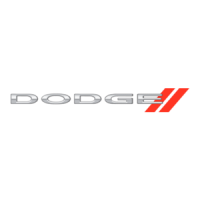
Do you have a question about the Dodge Challenger SRT 2016 and is the answer not in the manual?
| Brand | Dodge |
|---|---|
| Model | Challenger SRT 2016 |
| Category | Automobile |
| Language | English |
Explains how to navigate the owner's manual to find desired information effectively.
Details critical warnings and cautions to prevent collisions, bodily injury, death, or vehicle damage.
Provides information on the VIN's location on the instrument panel and other places.
Warns about the risks of modifying the vehicle, affecting roadworthiness and safety.
Details on the vehicle's keyless ignition system, RKE key fob, and push-button ignition.
Describes the Sentry Key Immobilizer system, preventing unauthorized vehicle operation by disabling the engine.
Details how the alarm monitors doors and trunk for unauthorized entry, and its audible/visible signals.
Explains how courtesy lights turn on when using the RKE key fob to unlock doors or open doors.
Covers locking/unlocking doors, opening the trunk, and activating the panic alarm using the RKE system.
Details on adjusting mirrors, automatic dimming feature, folding mirrors, and vanity mirrors.
Explains the BSM system using radar sensors to detect vehicles in blind spot zones, with warning lights and audible alerts.
Information on power seat adjustments, including forward/rearward, up/down, tilting, lumbar support, and heating/ventilation.
Provides instructions on how to open and close the vehicle's hood using release levers and safety catches.
Details the operation of the headlight switch, automatic headlights, high beams, and time delay features.
Details the operation of the intermittent wiper system, mist feature, and windshield washers.
Explains the Electronic Speed Control system, its operation and how to activate, set speed, and deactivate it.
Details Adaptive Cruise Control (ACC) operation, including activation, speed settings, and distance settings.
Provides information on ParkSense sensors, warning display, enabling/disabling, service, cleaning, and usage precautions.
Explains the ParkView Rear Back Up Camera system, its display, guide lines, and camera delay feature.
Describes the overhead console's features like courtesy lights, sunglass storage, and HomeLink button.
Explains HomeLink system for operating garage doors, gates, etc., and programming instructions.
Identifies key components of the instrument panel and their locations via numbered labels.
Provides a detailed view and explanation of the SRT instrument cluster, including tachometer, speedometer, and gauges.
Explains the function of various warning and indicator lights in the instrument panel, categorized by color.
Describes the interactive DID, its menu items, and how to navigate using steering wheel controls.
Discusses the vehicle's connected nature, security features, and the importance of software updates.
Explains how to access and change customer-programmable features through the Uconnect system's touchscreen and faceplate buttons.
Details the Performance Pages application for real-time display of performance indicators and vehicle capabilities.
Describes the Drive Modes feature for coordinating vehicle systems based on driving behavior, controlled via Uconnect or instrument panel buttons.
Outlines essential steps before starting the vehicle, including seat adjustment, mirror adjustment, and seat belt fastening.
Explains the function and connection of the engine block heater for easier starting in cold weather.
Covers the six-speed manual transmission, shifting, recommended shift speeds, skip shift, and downshifting.
Details automatic transmission operation, including key ignition park interlock and brake/transmission shift interlock systems.
Provides guidance on acceleration and traction when driving on wet, icy, or other slippery road conditions to maintain control.
Offers cautions and warnings regarding driving through standing, flowing, or rising water to prevent vehicle damage and ensure safety.
Explains the dual hydraulic brake system, its capability, and the function of the brake warning light.
Details advanced systems like EBD, ABS, BAS, HSA, TCS, ESC, and ERM that enhance vehicle stability and control.
Covers tire markings, including DOT safety standards, size designation, service description, load, pressure, and treadwear grades.
Advises against using tire chains due to limited clearance and potential vehicle damage.
Provides recommended tire rotation methods for vehicles with same or different tire sizes on front and rear axles.
Explains the TPMS operation, low pressure warnings, malfunction indicators, and sensor function.
Details the location and operation of the hazard warning flasher switch for emergency signaling.
Provides actions to reduce overheating potential in highways and city traffic, and steps to manage impending overheat conditions.
Covers safe procedures for jump-starting a discharged battery using jumper cables or a portable booster pack.
Explains how to use a rocking motion and gear shifting to free a vehicle stuck in mud, sand, or snow.
Provides a diagram identifying components within the engine compartment for the 6.2L Supercharged engine.
Explains the OBD II system, its monitoring functions, and the Malfunction Indicator Light (MIL).
Outlines required maintenance services determined by engineers for vehicle performance, reliability, and warranty.
Details scheduled maintenance services required at specific times or mileages for vehicle performance and warranty.
Presents a comprehensive chart outlining maintenance tasks at various mileage and monthly intervals.
Provides tips on preparing for service appointments, making lists of issues, and communicating effectively with service advisors.
Emphasizes the manufacturer's and dealer's interest in customer satisfaction and provides contact points for assistance.
Directs users to the Warranty Information Booklet for terms and provisions of FCA US LLC warranties applicable to the vehicle.
Instructs owners on how to report potential safety defects to NHTSA and the manufacturer, and discusses recalls.











